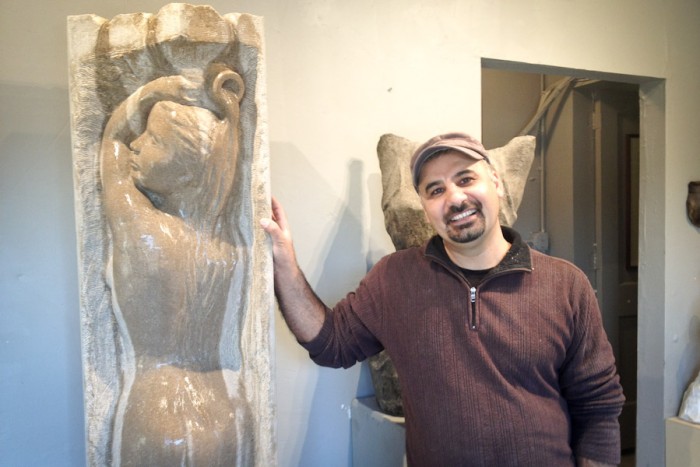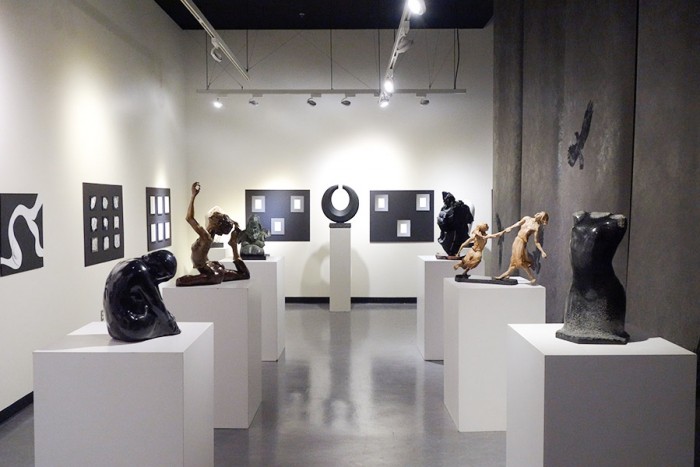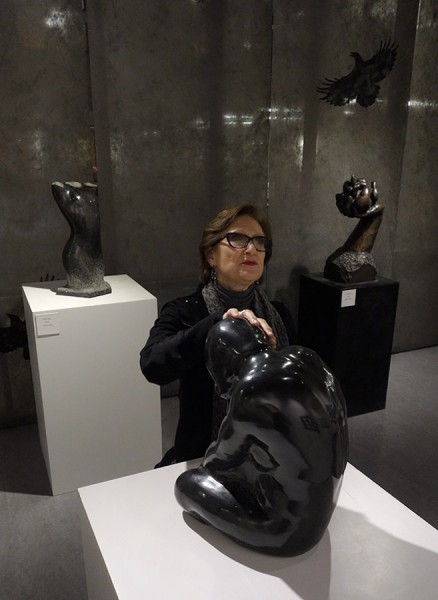
On a brief sunbreak in an otherwise gray day, I found myself peering through a garage door into a beautiful white space — part workshop, part gallery — filled with gorgeous oil paintings and a veritable pop up garden of stone and marble sculptures.
If you’ve used the on-ramp for the West Seattle Bridge at Delridge you might have seen it too. It’s what Iraqi artist Sabah Al-Dhaher refers to as “the mysterious place with all the marble.” Though Al-Dhaher has been at work in his West Seattle studio for the past eight years, it is only in the last year that he chose to open up the doors to the neighborhood. He’s gotten a warm welcome.
“They love it when they see me in here banging on the marble and making the sound. It literally stops traffic. People waiting in line to get on the bridge see it. Some of them might see it in the morning while they are getting ready to go to work and then come back later in the afternoon,” said Al-Dhaher of his studio’s open doors.
A classical artist by training, Al-Dhaher’s work centers on the human body.
“I see the human form as kind of my favorite subject. You can express so much emotion in it,” Al-Dhaher says.
In his studio there were small white marble nudes, the smooth contours of a woman’s face chiseled into a gray hunk of stone left ragged where her hair would be, and my favorite, a beautiful life sized fountain of a woman’s back. The water pouring out from a jug centered on her head like a shower.

“When you think of Iraq you think war, not art,” said Al-Dhaher, recalling his unlikely path to becoming an artist in Iraq. At age 15 he was accepted to a prestigious school for the arts modeled after European apprentice programs. There he learned to make his own oil paint.
“I got to study painting, sculpture, and ceramic.” But he didn’t find his favorite medium until he got to the U.S. “I lived in the south and we didn’t have stone, so most of the sculpture I did was clay and casting. The first time I saw stone was actually when I was here in Seattle. I saw a piece of marble and just fell in love with it. I taught myself how to carve it.”
Al-Dhaher arrived in Seattle in 1983 as a political refugee after two and half years living in a tent in the desert as a prisoner of war in Saudi Arabia. “Art through my whole life has allowed me to escape.”
Even as a prisoner Al-Dhaher continued to create.
“They allowed me to put a show on the fence, so on the wire I put these cardboard drawings I did,” he said, describing the pieces he made using only the cardboard from food rations. “It was a very interesting show, probably my all-time favorite show, but it can never be replicated. And it was really incredible just to allow these prisoners to have a show. The pieces were just sketches on cardboard because that’s the only thing that was there. We didn’t have any pens. It took a month just to get access to pens.”

When Al-Dhaher learned he would be allowed asylum in the United States, he did not speak any English and all he knew of his new country was Hollywood and New York. The immigration officers joked that he would not be able to survive in either place, so instead he came to Seattle. He’d a postcard from another refugee from the same camp who had relocated to Seattle two months earlier. After his time in the desert he was ready for rain.
Currently Al-Dhaher teaches at PRATT Fine Arts Center and has had his art displayed in several galleries. “I’ve showed a lot in schools and colleges, mostly for educational purposes to let students and people who don’t usually have the time to go to galleries to bring the art to their environment.”
This month, his work is part of an exhibit at Edmonds Community College that invites viewers to experience art in an unconventional way.
Please Touch, a show curated by artist Jim Ballard, dismisses the notion that fine art should only be experienced with the eyes, inviting participants to use their hands and their ears.

at left is Sabah’s “Female Torso” a basalt piece and to the right, background is Sabah’s bronze piece “Beginning.” These
are part of a current show titled Please Touch which is showing at the Edmonds Community College library gallery. (Photo by Jim Ballard)
“I’ve been working with children and adults who are blind or vision disabled. Often times there are not fine arts shows where they are able to touch the pieces.” explained Ballard, adding that every piece in this show is touchable.
Al-Dhaher and Ballard became friends through the Northwest Stone Sculptors Association. The exhibit also features pieces by two other sculptors: Richard Hestekind and David Varnau; paper embossments created by Ballard, and a series of seven long gray tapestries printed with ravens.
There is also a loop of three poems read by Holly J. Hughes about three extinct birds that appear in Ballard’s paper embossments. The entire exhibit is narrated in braile by Caroline Meyers.
“We combine braile and tactile illustrations used by children and adults so they can learn more about the world,” said Ballard.
“People think you can’t enjoy art, but you really can if people let you touch things,” said Camille Jassny, a woman with severe vision impairment, after a preview of the exhibit. Accompanied by Ballard, two friends and her dog Brietta, Jassny made her way from end to end experiencing each piece.
“Even if you can’t see, touching is its own way to experience art.”
Please Touch the art yourself:
Please Touch is open now through March 13, 2015
Edmonds Community College Art Gallery, Lynnwood Hall, Third Floor
20000 68th Avenue West, Lynnwood, WA.
Reception with the artists: Friday Jan. 23rd, from 3:30-6:30pm in the College Art Gallery.


let me touch your fcae my dear friend . 28 years ago , imiss you alot